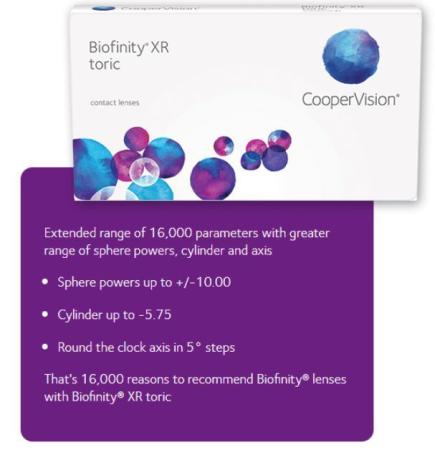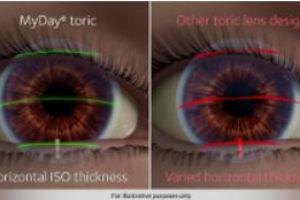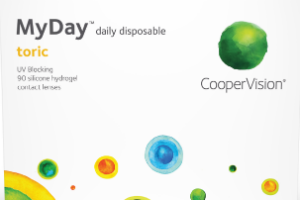Would you like more parameter options to fit your astigmatic patients? How about 16,000 options? That’s the power of Biofinity toric and XR toric, with its unrivaled parameter range for a silicone hydrogel toric lens. What about your myopes and hyperopes? Don’t worry, we’ve got them covered too with a spherical parameter range spanning from +15.0D to -20.0D – the widest parameter range of any monthly silicone hydrogel sphere product. The Biofinity product portfolio range is impressive, but how did we achieve this? The journey starts all the way back in 2013, when a brave, cross-functional project team set out to rethink how specialty contact lenses could be made. Join us on this journey as we talk to a few of the individuals involved in making the dream of extended parameters in silicone hydrogel materials a reality.
Biofinity® toric Parameter Range

Traditionally, XR parameter products have only been available in hydrogel or RGP lens types and have been created by lathing – a process whereby the lens is cut into its final shape. However, due to the different material characteristics of silicone hydrogels, it is not possible to lathe them so a different approach had to be taken to create extended parameters. CooperVision® needed to find a way to harness the precision and agility of cast molding with the flexibility of traditional lathing process. From this merging of precision, agility and flexibility, the Biofinity Made-to-Order or “MTO” line was created. The project started in 2013, but several technological breakthroughs were needed to overcome the immense challenge in scaling such a complex process while ensuring the same level of quality and consistency as our core Biofinity product ranges.
To understand more about the technological aspects of bringing the Biofinity XR range of products from early development to a manufacturing process we spoke to Steve English, the Sr. Director of the European Technology Improvement Group.
What’s different about the MTO line compared to our standard manufacturing processes?
We call it “manufacturing in reverse” because we have a completely different philosophy with our MTO line. With traditional manufacturing, you want large batch sizes to drive efficiency and you are trying to build inventory. With the MTO process, the batch size is 1 and the product is made-to-order after the order is received, thereby minimizing storage and inventory. While cost may be higher and throughput decreased, process flexibility is maximized enabling a larger diversity of products to be made. What’s common to both processes is a high level of accuracy and quality in the final product that is delivered.”

What was the key technological breakthrough in making this dream of made-to-order SiHy lenses a reality?
The critical part of this project was taking our already existing expertise in CL manufacturing and automated processes and marrying this with cutting edge digital technology, particularly, the ability to have full tracking and traceability of every individual contact lens on the line. To accomplish this we had to harness key concepts from the internet of things (IOT) and big data, alongside our already existing expertise in high precision silicone hydrogel lens manufacturing. This project required a seamless merging of the physical and the digital world. In fact, as part of the process development we created a digital simulator of the MTO-line which enabled us to test functionality and de-bug the physical process prior to “going-live” in manufacturing.
Can you give us some interesting stats about the MTO process and its capabilities?
With this process we have the capability of generating over 300,000 different SKUs (or unique lens parameters). The digital system robustness of the MTO line has enabled the manufacturing of over 7 million lenses without a single lost lens.
What do you think is the most exciting part of this process?
The Biofinity MTO line is the first and only of its kind in the world. It marries the cutting edge manufacturing automation and product quality that CooperVision is known for with frontier technology in the digital space. This was a great example of cross-functional collaboration of the IT, engineering and manufacturing teams within CooperVision to deliver a one-of a kind manufacturing platform to fulfill the needs of our customers and their patients.
The Biofinity MTO line has been in operation since 2016. To get insights on the day-to-day operation we spoke to Louise Dorrington, Sr. Manufacturing Manager for MTO products in the UK manufacturing facility, to understand how it all works.
What is it like to work on the Biofinity MTO line?
The team is passionate about producing an excellent quality product and meeting service times. We all know that there is an actual customer awaiting each lens being made on the line and that drives us to give our very best every day on the job.
What is the most exciting part of working on the Biofinity MTO line?
It’s the cutting edge technology. Having worked over 20 years in the contact lens industry, this is by far the most exciting project I’ve worked on and I’m proud to be part of this team that delivers these unique products to our customers.
We’ve come a long way on our journey to create a contact lens for nearly every patient that walks into your practice, but the adventure is just beginning. Biofinity toric is the fastest growing monthly toric lens and we have plans in the works to further expand our XR product range in the future. Stay tuned!
For more information on Biofinity XR sphere and XR toric you can visit the web-links below or contact your local CooperVision sales representative.
https://coopervision.com/practitioner/our-products/biofinity-family/biofinity-biofinity-xr








